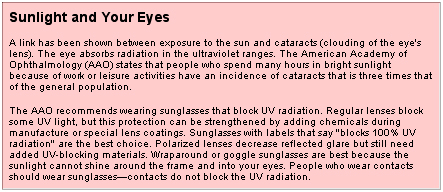 |
 |
 |
 |
ExperimentSunscreen Analysis: "Future so Bright, You've Got to Wear Shades"
Objective
In this experiment, the amount of ultraviolet light which passes through sunscreen (or a piece of colored transparency) and your sunglasses will be determined.Equipment
Cary 50 Spectrophotometer Personal Sunglasses or prescription glasses Microscope slideDiscussion
The radiation bathing the earth from our sun has a very wide spectral range. This means that the incoming light is made up of many different wavelengths (colors). Included in this life-giving radiation is damaging light that are harmful to organisms on the surface of the earth. Specifically, light in the ultraviolet region of the solar spectrum can be damaging to many organisms including human beings. Fortunately, our environment provides protection for the organisms that might be exposed to this harmful radiation.The atmosphere above the earth acts as a radiation filter in such a way as to remove significant amounts of ultraviolet radiation before it strikes the earth. The important chemical member of this atmospheric filter is ozone (O3). Ozone is involved in a continuous cycle of creation and destruction in the upper atmosphere called the Chapman Cycle (or mechanism) that also involves O2 molecules and O atoms. The net result of the Chapman Cycle is the transformation of incoming energy in the ultraviolet radiation from reaching the surface of the earth. This process occurs far above the surface of the earth and at a safe distance above plants and animals that can be damaged by ultraviolet radiation. It also acts to heat the upper regions of the stratosphere causing a natural temperature inversion there, but that is another story.
Part 1: Determining % Transmission by Sunscreen (or Colored Transparency)Procedure
1 Prepare to fill in the table in your work sheet / report which contains columns for "Wavelength (nm)" and "% Transmittance".Part 2: Do your sunglasses protect you against UV-radiation?2. Each group (2 individual per group) will receive two optical test tube. One of these is for calibrating your spectrophotometer, the other contains a sunscreen coating inside the test tube or a piece of colored transparency inserted in the tube.
3. Observe the instructor explanation on the calibration technique for the spectrometer.
Calibration: 4. Take your data and generate a plot in your worksheet of % transmittance (Y-axis) vs. wavelength-nm (X-axis) on the graph paper provided.A Set your spectrometer to 700 nm.
B. Calibrate 0 % transmittance with no testtube in spectrometer.
C. Calibrate 100% transmittance with testtube align in spectrometer.
D. Measure % transmittance for sample at this wavelength.
E. Move wavelength to 680 nm and repeat step B-D.
F. Move wavelength down another 20 nm and repeat B-D, until you have completed your data table. You must calibrate the instrument each time you change the wavelength.
5. Discuss your graph in terms of the question at the end of this experiment.
Procedure
1. Give your sunglasses to the instructor, who will analyze it on the CARY50 UV-VIS spectrometerResults2. Watch the instrument as the spectrum is being produced for you glasses.
3. Obtain a printout of the spectrum from your instructor.
4. Label the axes of the printout.
5. Submit this with your report.
Part 1. Construct a plot of "% Transmittance (Y-axis) versus wavelength (nm) (X-axis) on the graph paper provided. Indicate on your plot which wavelength correspond to the ultra-violet region and which to the visible region of the electromagnetic spectrum.
Reference:
1. Van Norstrand Reinhold Encyclopedia of Chemistry 4th Ed. p952
2. Extraordinary Chemistry or Ordinary Things, A laboratory Manual, Thomas, Richardson, & Bruce, JW&S, NY. 1992
3. Extraordinary Chemistry or Ordinary Things, Carl H. Snyder , JW&S, NY. 1992 p 595.
The InsturmentCary 50: Tutorial
Varian Intrument
Students Working with the Cary
Results:
Conclusion:This web page was completed in whole by Netscape 4.75. With no knowledge of html or computer programing, this webpage was created in less than an hour.